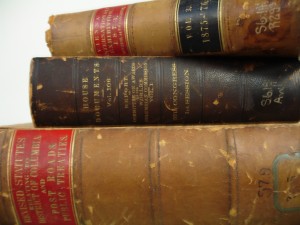 When filing a United States Supreme Court brief, there are distinctive formatting requirements that must be observed and followed. These requirements are set forth in Supreme Court Rule 33.1, which describes the Court’s required booklet formatting. Below are a few of the Supreme Court’s more obscure rules for filing in booklet format.
When filing a United States Supreme Court brief, there are distinctive formatting requirements that must be observed and followed. These requirements are set forth in Supreme Court Rule 33.1, which describes the Court’s required booklet formatting. Below are a few of the Supreme Court’s more obscure rules for filing in booklet format.
Every booklet-format Supreme Court brief must be produced on paper that is opaque, unglazed, 6⅛ by 9¼ inches in size, not less than 60 pounds in weight, and have margins of at least ¾ inch on all sides. The text field, including footnotes, should be approximately 4⅛ by 7⅛ inches. The brief must also have a suitable cover consisting of 65-pound weight paper.
The Supreme Court brief must be prepared using a standard typesetting process (e.g., computer typesetting, photocomposition, or hot metal) to produce text printed in typographic (as opposed to typewriter) characters. The process used should produce a clear, black image on white paper. The text must be reproduced with a clarity that equals or exceeds the output of a laser printer. Briefs produced on a personal computer using word processing, electronic publishing, or image setting are considered typeset and are acceptable. Briefs produced on a typewriter are not acceptable.
The booklet-format Supreme Court brief must be bound firmly in at least two places along the left margin so as to make an easily opened volume. No part of the text should be obscured by the binding. Saddle stitching or perfect binding is preferred. Staples may be used, with at least two along the left margin, covered with tape. Under no circumstances may spiral, plastic, metal, or string bindings be used.
The text of every booklet-format Supreme Court brief must be typeset in a Century family (e.g., Century Expanded, New Century Schoolbook, or Century Schoolbook) 12-point type with 2-point or more leading (pronounced LED-ing) between lines. The typeface of footnotes must be 10-point or larger with 2-point or more leading between lines. The text of the brief must appear on both sides of the page. Material contained in the appendix must also comply in all respects with the type-size and page-size requirements contained in Rule 33.1. Lower court orders and opinions issued on paper larger than 6⅛ by 9¼ inches may not be photo-reduced.
Leading is an old typesetter’s term and refers to the amount of added vertical spacing between lines of type. When type was set by hand in printing presses, strips of lead of appropriate thicknesses were inserted between lines of type to physically increase space between lines of metal type. Today, most word processing applications automatically apply standard leading based on the point size of the font. A 12-point typeface with 2 points of leading will produce a 14-point line space.
The requirements for producing a rule compliant Supreme Court brief can be both difficult to understand and difficult to comply with. At Cockle Legal Briefs, we are the experts when it comes to the Court’s intricate filing rules. We will save you time and effort, and more than that, our proofing will guarantee compliance as well as find any other problems in the original copy. Contact us when you are preparing your next Supreme Court brief and take advantage of our 91 years of experience in preparing legal briefs for submission to the United States Supreme Court.
